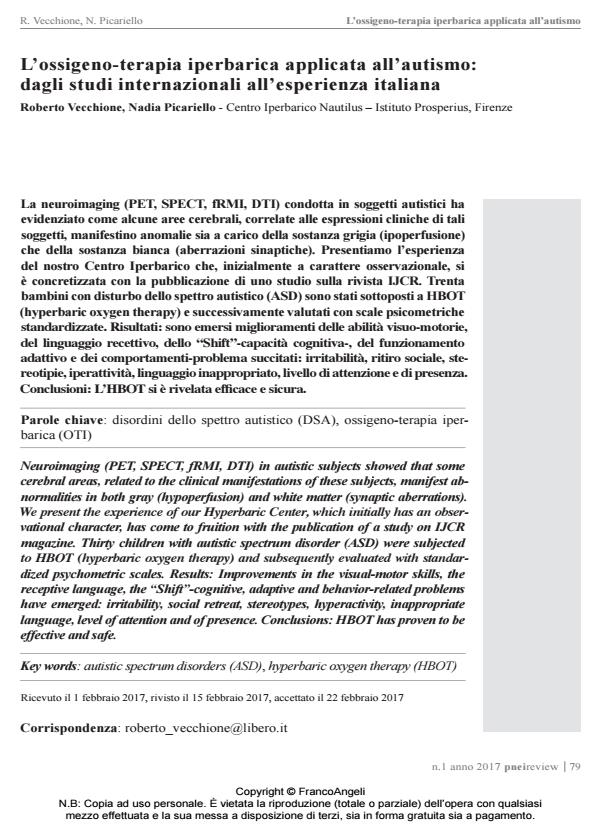L’ossigeno-terapia iperbarica applicata all’autismo: dagli studi internazionali all’esperienza italiana
Titolo Rivista PNEI REVIEW
Autori/Curatori Roberto Vecchione, Nadia Picariello
Anno di pubblicazione 2017 Fascicolo 2017/1
Lingua Italiano Numero pagine 13 P. 79-91 Dimensione file 1116 KB
DOI 10.3280/PNEI2017-001009
Il DOI è il codice a barre della proprietà intellettuale: per saperne di più
clicca qui
Qui sotto puoi vedere in anteprima la prima pagina di questo articolo.
Se questo articolo ti interessa, lo puoi acquistare (e scaricare in formato pdf) seguendo le facili indicazioni per acquistare il download credit. Acquista Download Credits per scaricare questo Articolo in formato PDF

FrancoAngeli è membro della Publishers International Linking Association, Inc (PILA)associazione indipendente e non profit per facilitare (attraverso i servizi tecnologici implementati da CrossRef.org) l’accesso degli studiosi ai contenuti digitali nelle pubblicazioni professionali e scientifiche
La neuroimaging (PET, SPECT, fRMI, DTI) condotta in soggetti autistici ha evidenziato come alcune aree cerebrali, correlate alle espressioni cliniche di tali soggetti, manifestino anomalie sia a carico della sostanza grigia (ipoperfusione) che della sostanza bianca (aberrazioni sinaptiche). Presentiamo l’esperienza del nostro Centro Iperbarico che, inizialmente a carattere osservazionale, si è concretizzata con la pubblicazione di uno studio sulla rivista IJCR. Trenta bambini con disturbo dello spettro autistico (ASD) sono stati sottoposti a HBOT (hyperbaric oxygen therapy) e successivamente valutati con scale psicometriche standardizzate. Risultati: sono emersi miglioramenti delle abilità visuo-motorie, del linguaggio recettivo, dello "Shift"-capacità cognitiva-, del funzionamento adattivo e dei comportamenti-problema succitati: irritabilità, ritiro sociale, stereotipie, iperattività, linguaggio inappropriato, livello di attenzione e di presenza. Conclusioni: L’HBOT si è rivelata effi cace e sicura.
Parole chiave:Disordini dello spettro autistico (DSA), ossigeno-terapia iperbarica (OTI)
Roberto Vecchione, Nadia Picariello, L’ossigeno-terapia iperbarica applicata all’autismo: dagli studi internazionali all’esperienza italiana in "PNEI REVIEW" 1/2017, pp 79-91, DOI: 10.3280/PNEI2017-001009